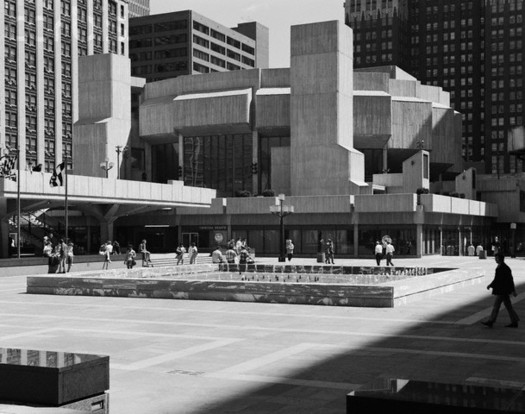
John Johansen's endangered Morris Mechanic Theater, in Baltimore, photographed by G. E. Kidder Smith
I began teaching a course in architecture writing last week, an occassion that forced me to think about critics and writers I might recommend as exemplary. The usual suspects naturally came to mind (Lewis Mumford, Ada Louise Huxtable, etc.) but I couldn't quite figure out where to begin until I came across a copy of G. E. Kidder Smith's Source Book of American Architecture, a compendium published by Princeton Architectural Press in my first years working there.
Kidder Smith is remembered (when he is remembered, which is not often enough) for his architectural photography, which can be found in many prominent collections and in every serious history of the that form. He began shooting in the late Depression years, and continued for most of his life (he died in 1997). He was a master of light and shadow, with a knack for giving volume and dimension to a building in two dimensions. He had a practitioner's eye for detail and context, and an obvious affection for his subject. Though he often photographed the works of high modernism, his images never seem clinical or detatched.
Kidder Smith was a gentleman of the old school, a native of Alabama educated at Princeton, and there's a certain courtliness to his writing. He had a long association with MoMA, a sponsor of the project that became Source Book, which began life as a three-volume documentation of American architecture, from the building of Native Americans pre-colonization through to the present. He also published books on the new architecture of Brazil, Italy, and Sweden, and contributed to just about every professional architecture magazine of note (Forum, Record, Review, PA....) Reviews for those publications played to his great strength as a writer: he was an absolute master of the short form. Your typical Kidder Smith piece begins with a historical lesson, pivots into a precise analysis of the work at hand, and exits gracefully with a closing thought or gesture, typically generous.
No architecture writer had a better sense of economy, a trait ideally suited to his penchant for writing pointed letters to the Times (and others), on subjects of architecture, urbanism, and preservation, often correcting the paper for inaccuracies or wrongheaded positions. In the days before the paper had a full time architecture critic (Huxtable, notably, also attracted attention through a letter), this was one of the few outlets for shaping public conversation. Kidder Smith was an effective advocate: among his achievements, he was instrumental in the preservation of Frank Lloyd Wright's Robie House and Le Corbusier's Villa Savoye.
Critical sharp-form writing working in tandem with compelling imagery; Kidder Smith would have been perfect for the Internet. He never really had the chance, but the lessons of his writing are perfect for a generation who will live on line, and a figure worthy of rediscovery.
—@marklamster
